Wildlife Migration and Seasonal Patterns in Uganda | WildHorn Africa Safari Guide
Imagine the golden light of dawn stretching across Uganda’s sweeping savannahs, while elephants move slowly toward a waterhole shimmering in the morning haze. Picture great flocks of birds rising over papyrus swamps, or herds of kob grazing against the backdrop of distant hills. These timeless images are not random; they are part of a grand natural rhythm that pulses through Uganda’s ecosystems.
The wildlife migration and seasonal patterns in Uganda reveal much about how this diverse land functions. Every creature, from the smallest butterfly to the largest elephant, is influenced by the country’s alternating wet and dry seasons. These cycles dictate where animals feed, breed, and migrate — shaping the very fabric of Uganda’s wilderness and determining when travelers experience its most breathtaking spectacles.
In this article, we take an in-depth journey into Uganda’s seasonal movements — exploring what drives them, how they shape safari experiences, and why understanding them can transform the way you explore the Pearl of Africa.
Understanding the Pulse of Nature: Rainfall, Vegetation, and Water
At the heart of Uganda’s wildlife patterns lies the interplay between rainfall, vegetation, and water. The country’s equatorial position gives it a unique balance — lush and fertile, yet defined by distinct wet and dry phases that repeat year after year.
Rainfall acts as the primary rhythm-maker. When the rains arrive, grasses sprout, trees fruit, and rivers swell with life. The dry months, on the other hand, bring scarcity and concentration. Water recedes, pastures thin out, and animals must travel further in search of sustenance.
Uganda’s wildlife doesn’t migrate over vast continental distances like the wildebeest of the Serengeti, but many species exhibit localized and seasonal movements. Antelopes shift to follow new grazing areas, elephants travel between watering points, and countless birds traverse wetlands and forests with the changing seasons.
Water is the essence that connects them all. When rivers and wetlands shrink, life converges around what remains. When rains return, the wilderness bursts outward once again in renewal. The pattern is ancient, cyclical, and vital — the true heartbeat of Uganda’s wilderness.
Seasons and Their Influence on Wildlife Movement
Uganda’s climate does not follow harsh winters and summers but rather cycles between two wet seasons and two dry seasons, each shaping the land and its wildlife in remarkable ways.
The Wet Seasons: Renewal and Expansion
The wet seasons — generally from March to May and October to November — are a time of abundance and growth. Rains fall across much of the country, transforming the landscape into a lush paradise of green. Rivers swell, insects multiply, and new vegetation provides food for grazers and browsers alike.
During this time, wildlife disperses widely. Animals move away from permanent water sources and spread across the plains, forests, and hillsides in search of fresh grazing and breeding grounds. The wet season often coincides with breeding and calving, as food is plentiful and conditions favor survival.
Birdlife is especially magnificent during this period. Uganda lies on key migratory flyways, and the rains attract countless migratory species from Europe and Asia. Wetlands such as Mabamba Bay, Lutembe Beach, and the Kazinga Channel become havens of avian diversity, where travelers can witness flamingos, herons, pelicans, and storks in dazzling displays.
For safari-goers, the wet season brings beauty, solitude, and color. The landscapes are lush, skies dramatic, and wildlife vibrant, though travel can be more challenging due to muddy tracks and dense vegetation.
The Dry Seasons: Concentration and Survival
Uganda’s dry seasons — from June to August and December to February — are the moments when the drama of survival takes center stage. With rainfall diminished, grasses wither and watering holes recede. Animals begin to congregate near permanent sources such as the Kazinga Channel, River Nile, and Lake Albert.
The concentration of wildlife during the dry months creates extraordinary safari opportunities. Lions, leopards, and hyenas linger near water points, awaiting prey. Herds of elephants, buffalo, and antelope gather in great numbers. The scenes can be both beautiful and intense — life clustered around scarcity, yet thriving in resilience.
This is the prime safari season for game viewing, as visibility is higher and animals are more predictable in their movements. Photographers favor this time for the clarity of light and easier access to wildlife sightings.
 Patterns Across Uganda’s Major Ecosystems
Patterns Across Uganda’s Major Ecosystems
Each of Uganda’s ecosystems has its own rhythm and seasonal pattern — shaped by its geography, altitude, and ecology. Understanding these regional nuances deepens the safari experience and reveals how interconnected Uganda’s wilderness truly is.
The Savannah Plains of Queen Elizabeth and Murchison Falls
In Uganda’s great savannah parks — Queen Elizabeth National Park and Murchison Falls National Park — wildlife movements are driven largely by the seasonal fluctuations of the rivers and grasslands.
During the dry seasons, the Kazinga Channel, Lake George, and Victoria Nile become lifelines. Elephants, hippos, and antelope gather near these permanent water bodies, while predators such as lions and leopards follow closely.
When the rains return, herds disperse into the wider plains to feed on new vegetation. The once-dry grasslands come alive with vibrant hues, and birdlife flourishes. The cycle of movement here is subtle but powerful — a dance of retreat and expansion that mirrors the ebb and flow of the seasons.
The Forest Ecosystems of Bwindi, Kibale, and Mgahinga
Uganda’s forests are ruled by different rhythms — not vast migrations, but localized, seasonal movements within dense vegetation. In Bwindi Impenetrable Forest, Kibale Forest, and Mgahinga Gorilla National Park, the patterns revolve around fruiting cycles and food availability.
Mountain gorillas, chimpanzees, and monkeys move through their territories in search of ripening fruits, young leaves, and blossoms. Their movements are often influenced by elevation and rainfall: during wetter months, primates may stay higher in the canopy or venture deeper into the forest, while drier periods may draw them closer to lower elevations.
These subtle patterns ensure a constant but shifting mosaic of wildlife activity, making forest trekking a uniquely dynamic experience year-round.
The Wetlands and Lakes of Central Uganda
The wetlands, lakes, and swamps — from Mabamba Bay on Lake Victoria to Lake Kyoga and Lutembe Beach — are sanctuaries of movement. Here, the migration of birds is among the most dramatic wildlife events in Uganda.
Between August and April, Uganda becomes a rest stop and feeding ground for migratory birds from as far as northern Europe and central Asia. The rains replenish fish populations and insect life, attracting herons, sandpipers, kingfishers, and the iconic shoebill stork.
As water levels fluctuate, birds move between shallower and deeper areas, turning the wetlands into living mosaics of motion and sound.
The Dry Valleys of Kidepo and Karamoja
In Uganda’s far northeast, Kidepo Valley National Park and the Karamoja region experience more extreme fluctuations. The dry season here can be harsh, forcing wildlife to migrate along river systems and across borders in search of food and water.
When the rains return, Kidepo’s grasslands burst into life. Buffaloes, elephants, and antelope reclaim the plains, and predators once again roam in abundance. These cycles of scarcity and renewal give Kidepo its untamed beauty — a rhythm as ancient as the land itself.
Bird Migration: The Sky’s Great Symphony
While Uganda’s mammal movements may be localized, its bird migrations are continental in scale. Over 250 migratory species pass through the country annually, joining more than 1,000 resident species to make Uganda one of Africa’s greatest birding destinations.
Bird migration is governed by global seasons and Uganda’s equatorial balance. When northern latitudes cool, flocks of storks, bee-eaters, swallows, and wagtails travel southward to Uganda’s wetlands and forests, where warmth and food abound.
By March and April, as the northern spring begins, these same travelers take wing again, leaving behind a landscape enriched by their temporary presence.
Wetlands like Mabamba Bay, Queen Elizabeth’s crater lakes, and Lake Bunyonyi come alive during this time — a spectacle of color and sound that transforms Uganda’s skies into a living symphony of wings.
The Subtle Migrations of the Great Mammals
Although Uganda does not host a vast transboundary migration like Kenya or Tanzania, it witnesses extraordinary micro-migrations that are vital to its ecosystems.
In Queen Elizabeth National Park, elephants and buffaloes move between the park’s northern and southern sectors depending on rainfall and vegetation cycles. The Ishasha plains see seasonal shifts in both antelope herds and tree-climbing lions, whose behavior may be influenced by prey movements.
In Murchison Falls, elephants and giraffes migrate seasonally between riverine and grassland habitats, while in Lake Mburo, zebra and impala patterns reflect local rainfall and pasture regeneration.
These internal migrations are critical to maintaining ecological balance. They prevent overgrazing, promote vegetation renewal, and sustain predator-prey dynamics — the invisible threads that hold Uganda’s wild tapestry together.
Conservation and the Future of Movement
The beauty of Uganda’s seasonal wildlife movement lies in its fluidity — yet that very fluidity depends on space, habitat, and ecological integrity. Wildlife corridors connecting parks such as Kibale and Queen Elizabeth or Murchison Falls and Karuma are essential to ensure that animals can continue their natural migrations.
As human settlement expands and climate change alters rainfall patterns, these routes face growing pressure. Protecting them means preserving the very essence of Uganda’s natural rhythm.
Conservation programs now focus on restoring connectivity — creating wildlife corridors, reducing conflict with communities, and monitoring climate-driven changes in migration. For travelers, supporting such initiatives through eco-conscious tourism ensures that the pulse of Uganda’s wilderness continues to beat strong.
Timing Your Safari: Following the Rhythms of Nature
Understanding these migration and seasonal patterns allows travelers to plan safaris that align perfectly with nature’s flow.
For those seeking abundant game and clear views, the dry seasons offer unparalleled opportunities. Wildlife gathers near rivers and lakes, visibility improves, and every drive reveals dense clusters of life.
For those who prefer lush landscapes, vibrant colors, and abundant birdlife, the wet seasons provide a feast for the senses. Forest trekking becomes particularly rewarding as primates are active and vegetation thrives.
Transitional months such as September and November often strike a perfect balance — fewer crowds, moderate weather, and wildlife on the move.
Whichever time you choose, aligning your safari with Uganda’s natural rhythm ensures that each moment — whether on a savannah plain, forest trail, or misty lake shore — resonates with authenticity and life.
Experiencing Uganda’s Seasons with WildHorn Africa
To truly connect with Uganda’s wildlife patterns, travelers need not only timing but expertise. This is where WildHorn Africa distinguishes itself. As a leading safari operator deeply attuned to Uganda’s ecosystems, WildHorn Africa crafts experiences that flow with the seasons rather than against them.
Whether it’s positioning guests near the Kazinga Channel during the dry months, organizing gorilla treks when forest conditions are optimal, or curating birding safaris during migration peaks, WildHorn Africa ensures that your journey aligns with the country’s living rhythm.
Through careful planning, knowledgeable guides, and authentic lodges, your safari becomes more than an adventure — it becomes an immersion into the cyclical heartbeat of Uganda’s wilderness.
Book your Africa tours and safaris via WildHorn Africa, and witness how every season tells a different story — from the emerald bloom of the rains to the golden stillness of the dry plains. Here, the land never sleeps, and the wild is always on the move.





 WildHorn Africa – Authentic and unforgettable tours across Africa, guided by local experts who know the land, wildlife, and culture best.
WildHorn Africa – Authentic and unforgettable tours across Africa, guided by local experts who know the land, wildlife, and culture best.


